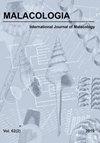Variation in the Sex Ratio of Apple Snails (Pomacea spp.) in Their Native Range
IF 1
4区 生物学
Q4 ZOOLOGY
引用次数: 4
Abstract
ABSTRACT The brood sex ratio of the apple snail Pomacea canaliculata is highly variable among parents in areas where it has been introduced. Such variation in the sex ratio may reflect variation in the source population, or it may have stemmed from the mixture of multiple source populations with different sex-determining mechanisms. To distinguish these hypotheses, the sex ratios of F1 (hatchlings from wild-collected egg masses) and F2 snails (produced from crosses of the F1 snails) from three sites in the native range in Argentina were studied. The sex ratios of the F1 snails were not significantly different from 0.5, although there was a slight but significant difference among populations. The F2 broods from intra-population crosses also lacked variation in the sex ratio. However, the sex ratios in F2 broods from inter-population crosses were highly variable, from 0 (all females) to 0.84 (mostly males). Thus, the large variation in the sex ratio in areas where P. canaliculata has been introduced is probably due to the mixture of source populations.苹果螺(Pomacea spp.)原产地性别比例的变异
摘要:苹果螺小管Pomacea canaliculata在不同地区的亲本间的幼代性别比差异很大。这种性别比的变化可能反映了源种群的变化,或者它可能源于具有不同性别决定机制的多个源种群的混合。为了区分这些假设,我们研究了阿根廷原生地三个地点的F1蜗牛(从野外采集的卵群中孵化的后代)和F2蜗牛(由F1蜗牛杂交产生的后代)的性别比。F1钉螺的性别比与0.5无显著差异,种群间差异虽小但显著。群体内杂交的F2后代在性别比上也没有变化。然而,群体间杂交F2代的性别比变化很大,从0(全部为雌性)到0.84(大部分为雄性)不等。因此,在引入小管柳的地区,性别比的巨大变化可能是由于源种群的混合。
本文章由计算机程序翻译,如有差异,请以英文原文为准。
求助全文
约1分钟内获得全文
求助全文
来源期刊

Malacologia
生物-动物学
CiteScore
2.00
自引率
0.00%
发文量
15
审稿时长
3 months
期刊介绍:
Malacologia publishes papers on all groups of the Mollusca. Malacologia specializes in publishing long papers and monographic treatments. Complete data are especially appreciated. Papers must be of interest to an international readership. Papers in systematics, ecology, population ecology, genetics, molecular genetics, evolution and phylogenetic treatments are especially welcomed. Also welcomed are letters to the editor involving papers published or issues of import to science of the day.
 求助内容:
求助内容: 应助结果提醒方式:
应助结果提醒方式:


